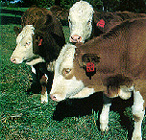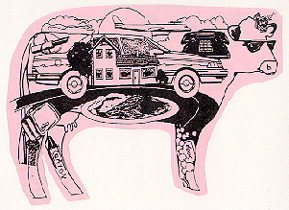 Top sirloin |  Simmental-Hereford cattle |  McDonald's Big Mac |
 Top sirloin |  Simmental-Hereford cattle |  McDonald's Big Mac |
Almost two-thirds of the land area of the United States is agricultural land, and two-thirds of the agricultural land is grazing land; 801 million acres of grazing land for 101,208,700 head of cattle. Why are we raising all of these animals? Beef and beef by-products are an integral part of our diet and environment. There are over 80 different breeds of cattle in the United States! The beef industry provides 1.6 million jobs, making it the largest segment of the U.S. economy! In 1995, U.S. consumers spent an average of $194.50 per person for beef.
 Drawing from the Florida Beef Council | Photographic film, crayons, linoleum, cake mixes, chewing gum, marshmallows, wallpaper, combs, basketballs, asphalt, airplane lubricants, insulin, and vitamin B12 all originate from the cow! |
| It is time to begin our journey...time to follow the steer from the farm to our dinner table. |

